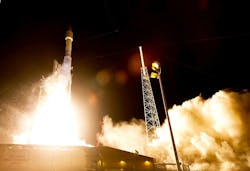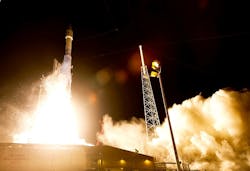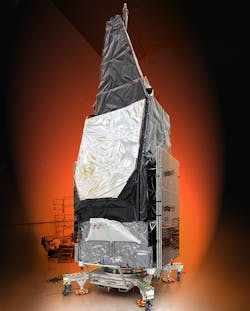Boeing and industry partners launch communications satellite into orbit for Mexican communications, transportation
REDMOND, Wash., 2 Oct. 2015. Boeing, Aerojet Rocketdyne (NYSE:AJRD), Lockheed Martin, United Launch Alliance (ULA), Orbital ATK, and other aerospace technology providers launched the Morelos-3 communications satellite into orbit for the Mexican Ministry of Communications and Transportation.
The mission was launched from Cape Canaveral Air Force Station in Florida by Lockheed Martin Commercial Launch Services aboard a United Launch Alliance Atlas V rocket. The launch vehicle had an Aerojet Rocketdyne RL10C-1 upper-stage engine, two AJ-60A solid rocket boosters (SRBs), six helium pressurization tanks, and a dozen Centaur upper-stage thrusters used for roll, pitch, yaw, and settling burns. Morelos-3 also carries a High Performance Apogee Thruster (HiPAT) bipropellant apogee insertion engine provided by Aerojet Rocketdyne's Space Systems business unit in Redmond, Washington.
The Atlas V rocket lifted off the pad with the help of two AJ-60A solid rocket boosters providing more than 760,000 total pounds of thrust. All Atlas V launches requiring extra boost performance have flown Aerojet Rocketdyne-produced SRBs, officials say. After the separation of the first stage, a single RL10C-1 engine ignited to place the payload into orbit, helped by the Centaur thrusters and other Aerojet Rocketdyne-provided hardware for both the booster and upper stage. The RL10C-1 engine delivers 22,890 pounds of thrust to power the Atlas V upper-stage, using cryogenic liquid hydrogen and liquid oxygen propellants during its operation. ARDE, a subsidiary of Aerojet Rocketdyne based in New Jersey, provides the pressure vessels on the first and second stages on the launch vehicle.
The Morelos-3, a Boeing (NYSE:BA) 702HP (high power) satellite and part of a capable and advanced mobile satellite system, is transmitting initial on-orbit signals as it makes its way to its final orbital location within Mexico’s new Mexsat system, Boeing officials confirm.
The Ministry of Communications and Transportation commissioned Mexsat, a state-of-the-art satellite-based mobile telecommunications system which increases communications capabilities for national security, civil, and humanitarian efforts by providing 3G+ voice and data services to mobile terminals across Mexico and its surrounding waters. The satellite will be operated by Telecomunicaciones de Mexico (Telecomm) on behalf of the Mexican government from two highly developed satellite control centers in Mexico.
“This latest milestone represents Boeing’s fourth generation of satellites for Mexico and underscores how our satellites’ capabilities improve daily and emergency communications,” says Mark Spiwak, president, Boeing Satellite Systems International.
Morelos-3 will join the country’s existing Mexsat constellation as its primary telecommunications satellite, helping to bring end-to-end communications support to areas of national security, civil, and humanitarian efforts. Morelos-3 is one of the satellites in the MEXSAT communications system, which is owned by Secretaria de Comunicaciones y Transportes and operated by Telecomunicaciones de Mexico. MEXSAT is designed to deliver advanced telecommunications throughout Mexico, including rural zones and to support Mexico's national security needs. Satellite services will include education and health programs, voice, data, video, and Internet services. The capabilities of an integrated Mexsat system will enhance Mexico’s disaster relief efforts, emergency services, telemedicine, rural education and telecommunications access for populations in remote locations of Mexico. Support in these areas is instrumental to positioning the country for infrastructure maintainability and future growth, officials say.
“The successful placement Morelos-3 into orbit is tremendous news for Mexico,” says Omar Charfén, Mexsat program director general. “Now, we can begin to use Morelos-3 to expand the already robust capabilities of our Mexsat communications network.”
The launch marks ULA’s 100th mission since the company was formed in late 2006 and the 57th Atlas V launch since the vehicle’s inaugural mission in 2002.
“The quality and reliability of the Atlas V is unparalleled, and today it delivered on a critical step toward bringing next-generation mobile telecommunications services to Mexico,” said Steve Skladanek, president of Lockheed Martin Commercial Launch Services. “The placement of Morelos-3 into orbit is vital to an effective Mexsat constellation, and partnering with ULA, we were able to help the customer achieve that mission.”
Orbital ATK in Dulles, Va., provided critical launch vehicle and satellite payload hardware for the Lockheed Martin (NYSE:LMT) Commercial Launch Services launch of Mexico’s Morelos-3 satellite aboard an Atlas V.
“With every launch I am reminded that the products we build are extremely important to our customers,” says Scott Lehr, president of Orbital ATK’s Flight Systems Group. “We are pleased to be a part of this important mission to help increase the telecommunications capability of the Government of Mexico.”
Orbital ATK’s contributions to the Atlas V and Morelos-3 satellite include cutting-edge technologies from across the company. Contributions include a large composite faring, retro motors, and propellant tanks for the rocket, and thermal and structural components on the satellite.
For the Atlas V rocket, Orbital ATK produced the 10-foot diameter composite heat shield, which provides higher performance with lower weight, and essential protection for the first stage of the launch vehicle from engine exhaust temperatures in excess of 4,000 degrees Fahrenheit. The assembly was fabricated using advanced fiber placement manufacturing techniques at Orbital ATK's Iuka, Mississippi facility. This is the 57th Atlas V launch using Orbital ATK-built composite structures.
This launch also marked the 22nd successful flight of Orbital ATK produced retro motors. Eight of these solid motors supported separation of the spent first stage. The Atlas V retrorocket is built at Orbital ATK’s Missile Defense and Controls facility in Elkton, Maryland.
For the Morelos-3 satellite, Orbital ATK provided the structures for the booms and the 22-meter payload antenna that make up the precision stable backing structure for the Harris deployable antenna. Orbital ATK’s Space Components Division facility in Magna, Utah, manufactured these components for the spacecraft. The division also supplied propellant tanks for the Atlas V rocket. Orbital ATK has provided similar structural components for the spacecraft industry for more than 35 years from sites in California and Utah. The Orbital ATK Beltsville, Maryland, facility manufactured the Loop Heat Pipes and payload heat pipes which are an integral part of the satellite’s thermal control system. Orbital ATK has delivered more than 50,000 heat pipes to the space industry with perfect, on-orbit mission success.
Boeing is responsible for the design, development, and delivery of this integrated system, comprised of a fixed service satellite and two Boeing geomobile satellites, two ground stations in Mexico for network and satellite control, and prototype user terminals. The first Boeing-built satellite for the Mexsat system launched in May 2015, but was lost due to a launch vehicle failure.
A unit of The Boeing Company, Defense, Space & Security specializes in capabilities-driven customer solutions and versatile military aircraft. Headquartered in St. Louis, Defense, Space & Security is a $31 billion business with 53,000 employees worldwide.
Orbital ATK, a provider of aerospace and defense technologies, designs, builds, and delivers space, defense, and aviation systems for customers around the world, both as a prime contractor and merchant supplier. Its main products include launch vehicles and related propulsion systems; missile products, subsystems and defense electronics; precision weapons, armament systems and ammunition; satellites and associated space components and services; and advanced aerospace structures.
Lockheed Martin Commercial Launch Services, a wholly owned subsidiary of the Lockheed Martin Corp., markets the Atlas V to commercial satellite customers worldwide and offers Athena launch services for small satellites and multi-payload RideShare missions. The company is responsible for contracts, marketing, sales, and mission management for commercial and international government Atlas V missions and all Athena missions.
Aerojet Rocketdyne provides propulsion and energetics to the space, missile defense and strategic systems, tactical systems, and armaments areas, in support of domestic and international markets.
You might also like:
Subscribe today to receive all the latest aerospace technology and engineering news, delivered directly to your e-mail inbox twice a week (Tuesdays and Thursdays). Sign upfor your free subscription to the Intelligent Inbox e-newsletter at http://www.intelligent-aerospace.com/subscribe.html.
Connect with Intelligent Aerospace on social media: Twitter (@IntelligentAero), LinkedIn,Google+, and Instagram.



